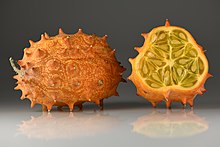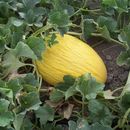Description
provided by Flora of Zimbabwe
Annual or perennial, monoecious or dioecious, herbs with climbing or prostrate stems. Leaves simple. Tendrils simple, simple at each node (except C. humifructus which has 2-8 at each node). Male flowers solitary or in few-flowered fascicles; female flowers solitary. Disk obvious, free from the receptacle-tube. Ovary smooth or bearing setae, spines or tubercles. Stamens 3, two 2-thecous, one 1-thecous.
- license
- cc-by-nc
- copyright
- Mark Hyde, Bart Wursten and Petra Ballings
- bibliographic citation
- Hyde, M.A., Wursten, B.T. and Ballings, P. (2002-2014). Cucumis Flora of Zimbabwe website. Accessed 28 August 2014 at http://www.zimbabweflora.co.zw/speciesdata/genus.php?genus_id=1443
- author
- Mark Hyde
- author
- Bart Wursten
- author
- Petra Ballings
Description
provided by Flora of Zimbabwe
Annual prostrate or climbing herb. Stems up to 5 m long, covered in bristly hairs. Leaves broadly ovate or subpentagonal in outline, more or less shallowly (3-)5-lobed, more or less densely bristly hairy, particularly on the veins below; margin with small sinuate teeth; petiole 2-11.5 cm long, covered in bristly hairs. Flowers unisexual, both sexes on the same plant, solitary or in 2-10-flowered clusters, yellow or pale orange, up to 2.5 cm in diameter. Fruits oblong-cylindric, up to 13 cm long, covered with stout fleshy spines, grey-green to orange yellow, often mottled, turning bright orange-red when ripe, edible.
- license
- cc-by-nc
- copyright
- Mark Hyde, Bart Wursten and Petra Ballings
- bibliographic citation
- Hyde, M.A., Wursten, B.T. and Ballings, P. (2002-2014). Cucumis metuliferus Naudin Flora of Zimbabwe website. Accessed 28 August 2014 at http://www.zimbabweflora.co.zw/speciesdata/species.php?species_id=157300
- author
- Mark Hyde
- author
- Bart Wursten
- author
- Petra Ballings
Worldwide distribution
provided by Flora of Zimbabwe
Widespread in tropical Africa
- license
- cc-by-nc
- copyright
- Mark Hyde, Bart Wursten and Petra Ballings
- bibliographic citation
- Hyde, M.A., Wursten, B.T. and Ballings, P. (2002-2014). Cucumis metuliferus Naudin Flora of Zimbabwe website. Accessed 28 August 2014 at http://www.zimbabweflora.co.zw/speciesdata/species.php?species_id=157300
- author
- Mark Hyde
- author
- Bart Wursten
- author
- Petra Ballings
Cucumis: Brief Summary
provided by wikipedia EN
 Horned melon (Cucumis metuliferus)
Horned melon (Cucumis metuliferus) Cucumis is a genus of twining, tendril-bearing plants in the family Cucurbitaceae which includes the cucumber (Cucumis sativus), muskmelons (Cucumis melo, including cantaloupe and honeydew), the horned melon (Cucumis metuliferus), and the West Indian gherkin (Cucumis anguria).
30 species occur in Africa, and 25 occur in India, Southeast Asia, and Australia. However, Cucumis myriocarpus was introduced to Australia from Sub-Saharan Africa, and is regarded as an invasive species.
- license
- cc-by-sa-3.0
- copyright
- Wikipedia authors and editors


 Horned melon (Cucumis metuliferus)
Horned melon (Cucumis metuliferus)